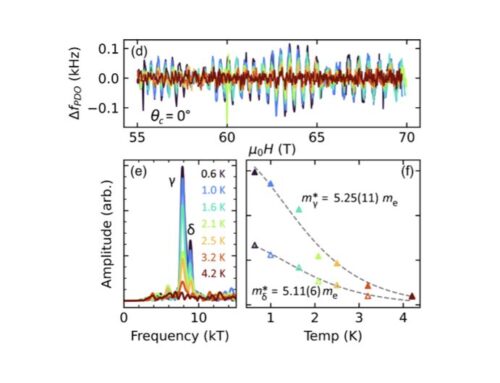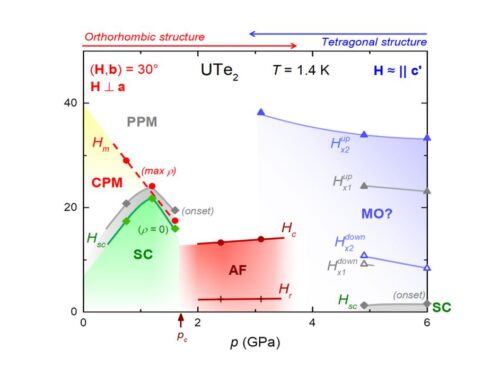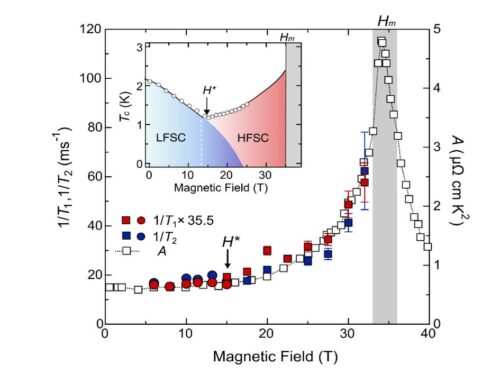S. Galeski, J. Gooth, MPI CPfS and T. Förster, HLD Dresden.
The quantum Hall effect is a prominent example of a quantum phenomenon that is of great importance for research in solid-state physics and the application of electronic devices. Since 1990, it defines the standard used in resistance calibrations. It is and was used to probe numerous topological states of matter and helped significantly to understand these systems. The quantum Hall effect is usually observed in two-dimensional metals, but now quantized Hall states appeared in high-quality crystals of HfTe5. A team from the Max Planck Institute for Chemical Physics of Solids (MPI CPfS) in Dresden, the Technische Universität Dresden, the Brookhaven National Laboratory, the Chinese Academy of Sciences, and HLD at the Helmholtz-Zentrum Dresden-Rossendorf discovered a new strongly correlated electronic state in this threedimensional metal that is a close relative of the two-dimensional quantum Hall state. Our measurements reveal an unconventional correlated electron state manifested in the Hall conductivity of the bulk semimetal HfTe5 in the quantum limit, adjacent to the 3D integer quantum Hall effect at lower magnetic fields. The observed plateaulike feature is accompanied by a Shubnikov-de Haas minimum in the longitudinal electrical resistivity and its magnitude is approximately given by 3/5(e2/h)kF,z/π, where kF,z is the relevant Fermi wave vector (Figure, left panel). To exclude that these features are caused by the presence of a second pocket at the Fermi energy, we have performed pulsed field magneto-transport measurements up to 70 T. These high-field measurements show no evidence for a second Fermi-surface sheet (Figure, right panel). Analysis of derivative relations and estimation of the gap energies suggest that this feature is related to quantum Hall physics. The absence of this unconventional feature in the quantum limit of isostructural single-band ZrTe5 samples with similar electron mobility and Fermi wave vector indicates the presence of a correlated state that may be stabilized by spin–orbit coupling.

Figure: Left panel: Longitudinal electrical resistivity ρxx (blue, left axis) and Hall resistivity ρxy (red, right axis) of HfTe5 as a function of B/BQL at T = 50 mK with the magnetic field B applied along the z direction for 0 T ≤ B ≤ 9 T. The blue arrows mark the onset of the Landau levels. BQL = 1.8 T denotes the magnetic field of the onset of the N = 1 Landau level. The blue numbers label the index N of the Landau level and the red numbers label the corresponding value of ρxy with respect to (h/e2)π/kF,z. Right panel: Longitudinal electrical resistivity ρxx of HfTe5 at 1.8 K as a function of magnetic field up to ±70 T
Unconventional Hall response in the quantum limit of HfTe5, S. Galeski, X. Zhao, R. Wawrzyńczak, T. Meng, T. Förster, P. M. Lozano, S. Honnali, N. Lamba, T. Ehmcke, A. Markou, Q. Li, G. Gu, W. Zhu, J. Wosnitza, C. Felser, G. F. Chen, and J. Gooth, Nat. Commun. 11, 5926 (2020).
https://www.nature.com/articles/s41467-020-19773-y
Contact: stanislaw.galeski@cpfs.mpg.de johannes.gooth@cpfs.mpg.de t.foerster@hzdr.de





